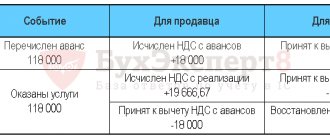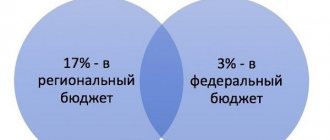Read on the topic: How to refinance a car loan at VTB 24 - can you save money?
Indeed, the main problem is the correct calculation. Experience shows that even professional accountants make mistakes. 2/3 of the rate is the indicator established by law for taxation of MV. To quickly calculate, we recommend using a loan calculator. It will not only save your time, but also avoid inaccuracies.
Penalties for late payment of taxes
Penalties for late fulfillment of tax payment obligations are determined as a percentage of the unpaid amount. In this case, the interest rate of penalties is taken equal to 1/300 of the refinancing rate of the Bank of Russia in force at that time (clause 4 of article 75 of the Tax Code of the Russian Federation).
Penalties, as a rule, are accrued for each calendar day of delay in fulfilling the obligation to pay tax, starting from the next day of payment, which is established by law.
The accrual of penalties stops on the day following the day of actual payment of tax arrears. Example 1
Norma LLC did not pay land tax in the amount of 6,000 rubles by the deadline of February 1, 2012. The organization repaid the specified debt only on March 30 of the same year. The refinancing rate of the Bank of Russia from February 2 to March 30 (58 days) was 8 percent (taken conditionally). Norma LLC calculated the amount of penalties in the amount of 92.8 rubles. (RUB 6,000 X 58 days X 8%: 300).
During the billing period, the discount rate may change, and more than once. The question arises: which of its values should be taken to determine penalties for late fulfillment of the obligation to pay tax in this case?
Here it should be borne in mind that when during the period for which penalties are accrued, the refinancing rate of the Bank of Russia changed both upward and downward, all its values for each period of validity are applied.
This is evidenced, for example, by resolutions of the FAS East Siberian District dated February 19, 2009 No. A19-9104/08-51-F02-493/2009, FAS Moscow District dated March 31, 2009 No. KA-A41/2507-09 . Let's look at what has been said with an example. Example 2
Akatsiya LLC did not pay the transport tax for 2011 in the amount of 10,000 rubles on time. The tax payment deadline is February 1, 2012. The organization paid off the tax debt in the following order:
- February 15 – 4000 rubles;
- March 2 – 6000 rub.
Thus, the amount of tax arrears was:
- from February 2 to February 14 (13 days) – 10,000 rubles;
- from February 15 to March 1 (17 days) – 6,000 rubles.
The refinancing rate had the following values (conditionally):
- from February 2 to February 10 (9 days) – 8%;
- from February 11 to February 20 (10 days) – 8.25%;
- from February 21 to February 29 (9 days) – 8.5%;
- from March 1 to 2 (2 days) – 8.25%.
Akatsiya LLC calculated the amount of penalties in the amount of 63.5 rubles. [(10,000 rubles X 9 days X 8%: 300) + (10,000 rubles X X 4 days X 8.25%: 300) + (6000 rubles X 6 days X 8.25%: 300) + (6000 rubles X 9 days X 8.5%: 300) + (6000 rubles X 2 days X X 8.25%: 300)].
Examples of calculations
It is best to give an example of calculating the refinancing rate based on the already indicated case of violation of payment deadlines.
So, if the employer delayed the employee’s wages, the amount of which is 20,000 rubles, for 5 days, then the amount of monetary compensation that the employee will have to receive will be minimal:
20,000 * 8.25% / 300 * 5 = 27.5 rubles
Although this amount seems small, with significant periods of delay and delay (both in payments and in lending), it increases significantly and can reach several thousand or even tens of thousands of rubles.
Material benefits from ruble loans
The income of an individual subject to personal income tax is, in particular, the material benefit received from savings on interest for the use of borrowed (credit) funds received from organizations or individual entrepreneurs and expressed in rubles. When a taxpayer receives income in the form of such a material benefit, the tax base is determined as the excess of the amount of interest for the use of borrowed (credit) funds, expressed in rubles, calculated on the basis of 2/3 of the current refinancing rate established by the Bank of Russia on the date the taxpayer actually received income, over the amount interest calculated based on the terms of the agreement. The basis is subparagraph 1 of paragraph 1, subparagraph 1 of paragraph 2 of Article 212 of the Tax Code.
Please note that taxable personal income tax income in the form of material benefits from savings on interest for the use of borrowed (credit) funds denominated in rubles arises for the borrower in cases where:
- the terms of the loan agreement (credit agreement) provide for the payment of interest at a rate equal to less than 2/3 of the refinancing rate of the Bank of Russia;
- the loan (credit) is interest-free.
Attention
If the loan agreement contains a condition on changing the interest rate, regardless of whether it has changed or not, when calculating expenses in the form of interest, the refinancing rate of the Central Bank of the Russian Federation, effective on the date of recognition of interest, is applied. This follows from paragraph 1 of Article 269 of the Tax Code.
Features of the procedure
You need to know in advance how the lender will calculate interest. This needs to be agreed upon “onshore”, if possible. But, as a rule, lenders do not notify their clients about the method of calculating interest.
If the client knows how they will be calculated, then he can do it himself. But for this you need some documents.
What documents need to be provided
All information about the loan must be contained in the following documents:
| The contract itself | here, as a rule, the parties indicate all the parameters of the loan issued |
| If something changes or is added, the parties can enter into an additional agreement | it is an annex to the main agreement, and not an independent document |
| Payment schedule | this document is issued if the lender or borrower is a bank or microfinance organization, and the loan itself is repaid as an annuity. The schedule is not an independent document; without a corresponding agreement, it has no legal force. It contains information about the date of each payment and the exact amount of the deposit. The schedule is signed by each party to the transaction. Sometimes, at the end of the document, banks indicate the formula by which they calculate the interest |
| Checks or other payment documents confirming payment of part of the loan | they are necessary if the borrower wants to repay the “body” of the loan ahead of schedule, and requires recalculation of interest based on the actual time of use of the funds |
The loan payer must have all these documents with him in case of conflict situations with the lender.
Rate used
When receiving income in the form of material benefits, the date of actual receipt of income is determined as the day the taxpayer pays interest on the borrowed (credit) funds received (subclause 3, clause 1, article 223 of the Tax Code of the Russian Federation). This means that when calculating the material benefit on ruble loans (credits), you should use the Bank of Russia refinancing rate valid on the day of actual payment of interest.
For information
The refinancing rate refers to the rate at which the Central Bank of Russia lends funds to credit institutions. It is clear that banks cannot lend to legal entities or individuals at a lower interest rate.
The refinancing rate of the Bank of Russia, established on the date of actual repayment of the loan amount, is used to calculate the amount of savings on interest on an interest-free loan. After all, the date of actual receipt of income in the form of material benefits from savings on interest for using an interest-free loan (credit) should be considered the date of return of the borrowed (credit) funds by the taxpayer. This is evidenced by letters of the Ministry of Finance of Russia dated July 25, 2011 No. 03-04-05/6-531, dated January 22, 2010 No. 03-04-06/6-3, dated July 17, 2009 No. 03-04 -06-01/175 and dated April 14, 2009 No. 03-04-06-01/89.
So, based on the above, for an interest-bearing ruble loan, the tax base (NB) can be determined by the tax agent using the formula:
NB = P2/3BR – Pdog , where
P2/3BR – the amount of interest based on a rate equal to 2/3 of the Bank of Russia refinancing rate in effect on the date of payment;
Pdog – the amount of interest payable according to the terms of the loan (credit) agreement.
The amount of interest payable under the terms of the loan (credit) agreement (Pdog) is determined by the formula:
Pdog = Сз X PSdog: KDg X KDpol , where
Сз – loan (credit) amount;
PSDog – the interest rate established in the loan (credit) agreement; KDg – the total number of calendar days in a year;
KDpol – the number of days of using borrowed (credit) funds.
To calculate the amount of interest based on a rate equal to 2/3 of the Bank of Russia refinancing rate in effect on the date of payment (PR2/3BR), the formula is used:
P2/3BR = Sz X PS2/3BR: KDg KDpol , where
PS2/3BR is an interest rate equal to 2/3 of the Bank of Russia refinancing rate in effect on the date of interest payment.
If a ruble loan is interest-free, then the tax agent calculates the tax base (TB) using the following formula:
NB = SZ X PS2/3CB: KDtot KDuser , where
SZ – loan (credit) amount;
PS2/3CB – interest rate equal to 2/3 of the Bank of Russia refinancing rate in effect on the date of repayment (partial repayment) of the loan (credit);
KDtot – the total number of calendar days in a year;
KDuse – the number of days of use of borrowed (credit) funds.
Example 3
Volna LLC provided manager P.P.
Karasev received a loan in the amount of 26,000 rubles. for two months at 3 percent per annum on February 1, 2012. According to the terms of the loan agreement, the employee returns 13,000 rubles towards the principal debt on the last day of each month. with the simultaneous payment of interest for the use of borrowed funds. In this case, the amount of accrued interest is withheld from his salary. The Bank of Russia has set a refinancing rate of 8 percent per annum. It does not change until the end of the contract. February 29, 2012 P.P. Karasev returned part of the loan in the amount of 13,000 rubles, and on the same day the accountant of Volna LLC withheld interest calculated for February in the amount of 59.67 rubles from his salary. (RUB 26,000 X 3%: 366 days X 28 days). The interest rate, calculated based on 2/3 of the current refinancing rate of the Bank of Russia, is equal to 5.333% (8% X 2: 3). This means that Volna LLC provided a loan to the employee at a rate of less than 2/3 of the current refinancing rate of the Bank of Russia (3% < 5.333%). Therefore, Karasev receives income in the form of material benefits from savings on interest, which is included in the tax base for personal income tax. The amount of interest calculated on the basis of 2/3 of the Bank of Russia refinancing rate in effect on the date of interest payment for February is equal to 106.08 rubles. (RUB 26,000 X 5.333%: 366 days X 28 days). The amount of material benefit from savings on interest in February amounted to 46.41 rubles. (106.08 – 59.67). On March 31, 2012, Karasev returned to Volna LLC the remaining part of the loan in the amount of 13,000 rubles. and paid interest for this month in the amount of 31.98 rubles. [(RUB 26,000 – RUB 13,000) X 3%: 366 days. X 30 days]. The employee again generates income in the form of material benefits from savings on interest. After all, the refinancing rate of the Bank of Russia did not change on this date. The amount of interest calculated for this month based on 2/3 of the Bank of Russia refinancing rate is equal to 56.83 rubles. [(RUB 26,000 – RUB 13,000) X 5.333% : : 366 days X 30 days]. Consequently, the amount of material benefit from saving on interest for March amounted to 24.85 rubles. (56.83 – 31.98). Example 4
CJSC “Two Oceans” on February 1, 2012 provided storekeeper L.B. Akulov received a loan of 30,000 rubles. for two months. According to the terms of the agreement, no later than the 1st day of each month, he must return 15,000 rubles monthly. principal debt (loan). The loan provided to Akulov is interest-free. From the beginning to the end of the loan agreement, the refinancing rate of the Bank of Russia was 8 percent. On February 29, 2012, Akulov repaid the first part of the loan in the amount of 15,000 rubles. At the same time, he had income in the form of material benefits from saving on interest. The interest rate, which is 2/3 of the current refinancing rate of the Bank of Russia, is equal to 5.333 percent (8% X 2: 3). Thus, the amount of income for the period from February 2 to February 29, 2012, which ZAO “Two Oceans” calculated on February 29, 2012, amounted to 122.40 rubles. (RUB 30,000 X 5.333%: 366 days X 28 days). The personal income tax calculated from the specified amount of income was withheld by the accountant of Two Oceans CJSC from Akulov’s salary for February 2012. The next part of the loan in the amount of 15,000 rubles. The storekeeper returned it on March 30, 2012. On this day, the organization calculated the income in the form of material benefits received by Akulov from savings on interest for the period from March 1 to March 30, 2012. It amounted (taking into account the loan amount repaid on February 29, 2012) to 65.57 rubles. [(RUB 30,000 – RUB 15,000) X 5.333%: 366 days. X 30 days]. CJSC “Two Oceans” withheld the personal income tax calculated from this income from Akulov’s salary for March 2012.
Interest limit
In the absence of debt obligations issued in the same quarter on comparable terms, as well as at the choice of the taxpayer, the maximum amount of interest recognized as an expense is accepted from January 1, 2011 to December 31, 2012 inclusive, equal to the interest rate established by agreement of the parties. At the same time, it should not exceed the refinancing rate of the Bank of Russia, increased by 1.8 times (clause 1.1 of Article 269 of the Tax Code of the Russian Federation). This applies to expenses in the form of interest on debt obligations incurred from January 1, 2010.
The mentioned rate should be understood as:
- in relation to debt obligations that do not contain a condition on changing the interest rate throughout the entire term of the debt obligation,
- the Bank of Russia refinancing rate in effect on the date of raising funds;
- in relation to other debt obligations - the refinancing rate of the Bank of Russia, effective on the date of recognition of expenses in the form of interest.
For loan agreements and other similar agreements, the duration of which falls on more than one reporting period, for the purpose of calculating income tax, the expense is recognized as incurred and is included in the appropriate expenses at the end of the month of the corresponding reporting period. In the event of termination of the agreement (repayment of the debt obligation) before the expiration of the reporting period, the expense is recognized as incurred and is included in the corresponding expenses on the date of termination of the agreement (repayment of the debt obligation). This is stated in paragraph 8 of Article 272 of the Tax Code.
The Ministry of Finance pays attention
The agreement may provide for the payment of interest or the repayment of an interest-free loan at any frequency. And if the interest-free loan agreement provides for monthly repayment of the loan, income in the form of material benefits will arise on each date of repayment of the borrowed funds, that is, monthly. The Russian Ministry of Finance drew attention to this in a letter dated July 25, 2011 No. 03-04-05/6-531.
Let's say that a credit agreement (loan agreement) contains a condition on changing the refinancing rate of the Bank of Russia for using a credit (loan).
Then the maximum amount of interest for the use of borrowed funds must be calculated monthly based on the discount rate in effect on the last day of the calendar month. And if the debt obligation is repaid before the end of the reporting period - on the date of repayment of the borrowed funds. Moreover, changes in the refinancing rate of the Bank of Russia during the month are not taken into account when determining the amount of interest. Example 5
LLC Riturnel received a loan from the bank on February 1, 2012 under a loan agreement containing a condition on changing the interest rate during the entire term of the debt obligation. On February 1, 2012, the Bank of Russia refinancing rate was 8 percent, and from the 20th it was reduced to 7.75 percent. Riturnel LLC will calculate the amount of interest recognized in tax accounting for February based on a discount rate of 7.75 percent.
If the credit agreement (loan agreement) does not contain a condition on changing the interest rate for using the credit (loan), then the maximum amount of interest expenses is determined monthly based on the discount rate in effect on the date of receipt of credit (borrowed) funds.
Example 6
Arabesk LLC received a loan in the amount of 160,000 rubles on February 1, 2012. at 18 percent per annum. The loan agreement does not contain a condition on changing the interest rate for using the loan. The organization repaid the loan on time - March 20 of the same year. The refinancing rate of the Bank of Russia, in effect on the date of raising funds, that is, on February 1, 2012, is 8 percent. This means the marginal interest rate will be 14.4 percent (8% X 1.8). Arabesk LLC paid 2,281.97 rubles for the use of borrowed funds in February. (RUB 160,000 X 18%: 366 days X 29 days). However, for profit tax purposes, the organization took into account interest expenses in the amount of 1,825.57 rubles at the end of February. (RUB 160,000 X 14.4%: 366 days X 29 days). For the use of borrowed funds from March 1 to March 20, 2012, Arabesk LLC paid 1,573.77 rubles. (RUB 160,000 X 18%: 366 days X 20 days). However, for profit tax purposes, the organization took into account the interest expense in the amount of RUB 1,259.02 on the date of repayment of the loan funds. (RUB 160,000 X 14.4 5%: 366 days X 20 days).










